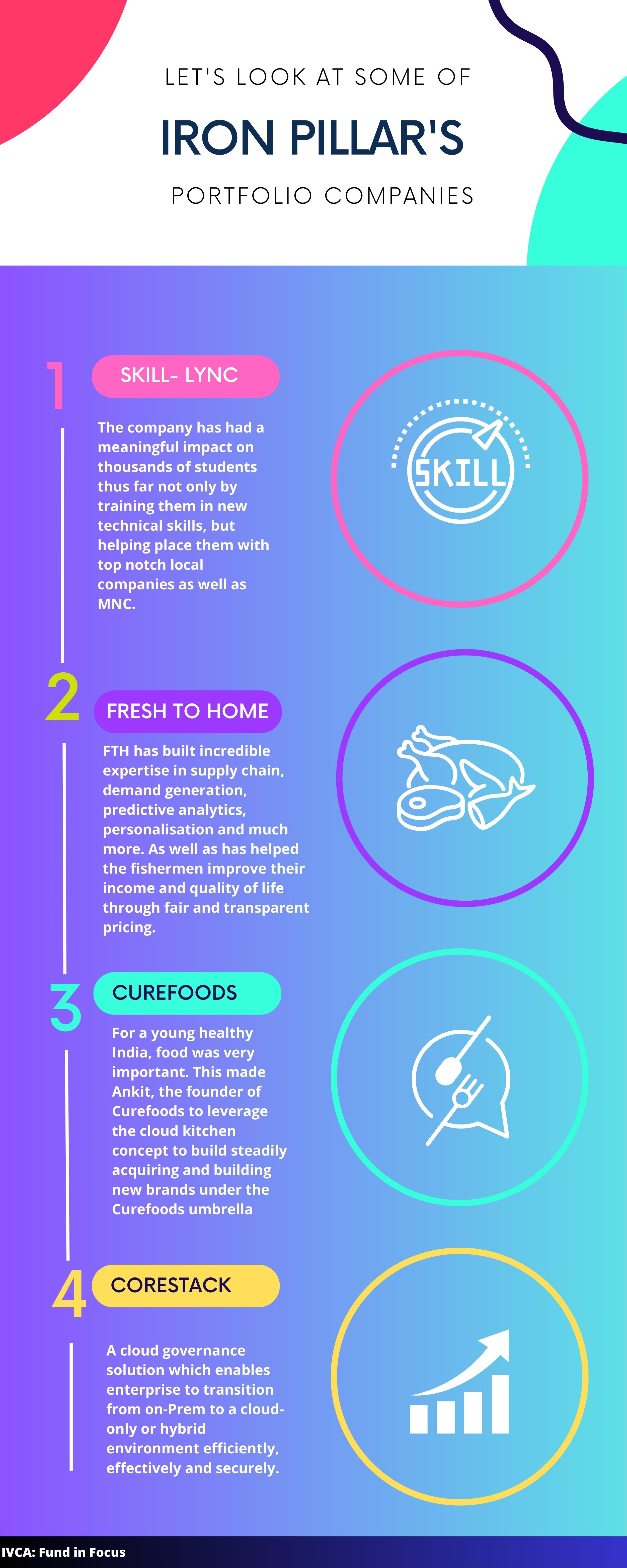Welcome to our ‘Fund in Focus’ series where we profile our member funds, underscore their investment philosophy, and highlight some of their interesting work. Today we speak to Mohanjit Jolly, Partner, Iron Pillar. In this feature he shares the venture fund’s vision to back high value start-ups who are “building from India for the world”, the close of its $129Mn cloud fund, top investment trends and the fund’s bullish approach towards investing in enterprise centric sectors in 2023.

FUND IN FOCUS: Iron Pillar's Winning Startup Formula Combines Art and Science in Venture Investing

Mohanjit Jolly
1. True blue mid-stage growth venture investors are limited in India and Iron Pillar is one of the prominent ones operating in this space. How would you describe the fund’s investment strategy for ‘new India’.
The team at Iron Pillar believes, as do many others, that the roaring 2020’s is India’s decade in terms of innovation and entrepreneurship. Iron Pillar has been a fundamental believer in backing startups “building from India for the world” ever since our founding seven years ago. Most of our investments address global markets, in addition to India and we believe that Indian entrepreneurs will continue to build large global technology companies from India. That thesis is paying dividends given the massive growth that virtually every one of our investments is witnessing.
In terms of capital invested, we invest $10-15M in the initial round of our entry in a company and then double down on our winners for ~$50M. We prefer to own 10% to 30% of the businesses we invest in.
2. How do you spot your 'winning' start-ups?
VC investing is a combination of art and science, qualitative and quantitative, eq and iq, the emotional and the rational, leveraging the heart/gut/intuition and the mind. Iron Pillar invests in companies that are post the early-stage product-market risk, and usually when the ARR is between $4M and $10M (for SaaS companies, for example). Therefore, there is market and financial data that can be analyzed, looking for trends around typical financial metrics such as Gross Margins, YoY growth, Customer Acquisition Cost etc. The Iron Pillar team has created its own rubric to analyze investment opportunities based on the business data. But often, the decision making comes down to our fundamental belief in the entrepreneur(s) to execute and scale the business. We have a “force of nature” question whereby we look for that combination of self-awareness, resilience, and grit on the part of the entrepreneurs to overcome headwinds. Additionally, entrepreneurs need to have the ability to sell, not just the product but also the vision of the company. That attracts employees, customers, and downstream investors. At Iron Pillar, we are looking for companies that aim to be unicorns, in large markets, with global ambitions. The calculus for us is a combination of the team (first and foremost), technology (potential for #1 or #2 in their industry), traction (product-market fit, retention, positive CAC and CAC payback trends etc.) and sizable market to create a billion-dollar+ outcome.
3. How are you deploying new capital so far in 2022 and plan to utilize it next year?
The team has been busy making new investments and working deeply with existing companies over the last few quarters. Till date, Iron Pillar Fund II has invested in six companies mostly focused on our thesis of building from India for the world. We have formally announced five of those investments (CoreStack, Ushur, Jiffy.ai, Skill-Lync and Curefoods). All these investments leverage the Cloud as the enabling infrastructure with most of them falling in the SaaS category. We will be active in calendar 2023 continuing to make new investments. Our strategy is one of a concentrated portfolio and going deep with our portfolio companies in terms of hands-on help with business development, recruiting, GTM and downstream capital. That approach has helped build a strong reputation for the brand and resulted in significant referral network being created in the market through our existing portfolio entrepreneurs, co-investors, LPs and the broader startup ecosystem.
4. Iron Pillar's close of its $129 million cloud fund, do elaborate on the cloud opportunity and impact on India's digital economy in the coming years.
As we think about companies “building from India for the world”, cloud is a foundational technology that enterprise and consumer centric companies have leveraged, are leveraging and will leverage going forward, either exclusively or in conjunction with on-premise solutions.
Our Global Cloud Fund’s emphasis is primarily enterprise-centric SaaS companies. Several of our star investments from this fund, including Ushur, Pando, Jiffy and CoreStack, are “cloud native”, meaning that their product is architected from the ground up to take advantage of the flexibility, scalability, maintainability and agility that the cloud provides. CoreStack itself is a Cloud Governance solution which enables enterprise to transition from on-Prem to a cloud-only or hybrid environment efficiently, effectively and securely.
Global cloud spend in 2023 is projected to grow to almost $600B, up from $400B two years ago. Overall IT spend is forecasted to be $4.6T in 2023. So while the cloud spend is definitely becoming a bigger piece of the IT pie, that trend will likely continue for several years to come. While public cloud vendors like AWS, GCP and Azure will clearly be large beneficiaries, many start-ups at the infrastructure and application layers will benefit as well. India will definitely provide more than its fair share of start-ups that will be part of that cloud wave. Finally, disruptive technologies such as generative AI are built natively in the cloud and are acting as yet another catalyst for further cloud adoption.
5. Elaborate on the impact created by some of your portfolio companies in consumer-tech space.
Iron Pillar’s portfolio include high performing consumer-tech companies such as FreshToHome, BlueStone and CureFoods as well as consumer + B2B companies like Servify and Skill-Lync. Skill-Lync, our star engineering upskilling company, is building a stellar platform for training for future-ready jobs in categories such as Automotive (think EV’s and Battery Management), Telecommunications (think 5G transformation), Defense and Aerospace and more. The impact from a platform like Skill-Lync is obvious and significant. Whether its fresh college graduates looking for job-ready, project-centric skills, mid-career individuals fighting obsolescence in a particular market by re-inventing themselves, Skill-Lync is life changing. The company has had a meaningful impact on thousands of students thus far not only by training them in new technical skills, but helping place them with top notch local companies as well as MNC.
FreshToHome is another phenomenal company in the consumer-tech space focused on providing fresh fish and meat from the source directly to the consumers at a competitive price, without any preservatives within 24-36 hours. Technologically, the company has built incredible expertise in supply chain, demand generation, predictive analytics, personalization and much more. Shan, the co-founder and former head of Zynga, India is a true “force of nature” with laser focused execution that has led FTH to become a leader in their category. The company has grown from India to the UAE market, and now expanding into other parts of the Middle East. FTH’s impact is really two-fold – for the consumers, the company delivers the highest quality, fresh product through a combination of value and convenience; just as importantly, they help the fishermen improve their income and quality of life through fair and transparent pricing. The company also has, as part of the Kerala heritage, a mission of giving back to the local fishermen communities, something that is a rarity in the overall entrepreneurial ecosystem.
Curefoods is one of Iron Pillar’s more recent investments. And again, the investment thesis was focused in large part of Ankit Nagori, the founder/ceo as well as the burgeoning market for healthy and tasty food in the Indian market. One of Ankit’s passions is “healthy lifestyle”. After a successful career at Flipkart, he and Mukesh Bansal co-founded Curefit which was eventually acquired by the Tata Group. Ankit decided that for a young healthy India, food was just as important, if not more so, than exercise. Being a technologist at heart, he leveraged the cloud kitchen concept to build Curefoods, steadily acquiring and building new brands under the Curefoods umbrella. As a result, Curefoods is now the second largest house of food brands in India, impacting thousands and soon, tens of thousands of Indians with healthy, convenient, and affordable food options. Now that’s impact!

6. With record dry powder waiting to be invested, capital investment today is at a tipping point in India. What’s your outlook for funding revival in 2023?
2023 is going to be a very interesting year for the Indian tech startup ecosystem. Investors who have dry powder, like Iron Pillar, will be in a good position to invest in interesting companies at relatively reasonable valuations compared to the last few years. At the same time, investors with sizable portfolios and companies facing cash crunch in the coming months and quarters may be forced to deploy capital in their existing companies through convertible notes/SAFEs or through insider-led rounds. Investors who have been disciplined about valuations and not getting caught up in the FOMO trends will do well in 2023. From a startups’ standpoint, those who are solving real problems and finding true product-market fit, will be able to raise capital, although they will have to have more realistic valuation expectations and will have to ensure that cash burn is controllable. Investors may still worry in 2023 to back high cash burning businesses without a clear path to profitability. We suspect that the overall investment and diligence process will be longer as investors will likely spend more time and dig deeper into the business before investing. We have started to see those trends earlier this year, and expect them to continue throughout 2023. Another trend to keep an eye on will be M&A and consolidation in certain sectors where scale will matter and therefore, multiple companies coming together will be the right recipe for long term success rather than the “go it alone” approach. We are starting to see that trend already.
7. Which sectors will be significant growth drivers for Indian digital economy?
There are several sectors to be excited about within the Indian digital economy. India’s young demographic and constant digitization across metros and tier 3/4/5 towns and villages create huge tailwinds for several sectors. Fin-tech and logistics were both pre-cursors and beneficiaries of the e-commerce and m-commerce growth; one of Iron Pillar’s core investment themes is future of work and education. With a young, aspirational, connected demographic, education and skilling are not “nice to have’s” but “must have’s” for India to prosper and not run into an issue of high unemployment. There is a massive need and opportunity around sustainability and climate-change centric technologies, not just in terms of mimicking successes in the US or Europe, but coming up with a very bespoke set of solutions for the Indian market, infrastructure and customer set. Climate change is driving several other trends that technologies and startups will need to address, around sustainable agriculture, housing, pollution, waste, water etc. With a young population, immersive entertainment, gaming, edutainment will be interesting themes. And while healthcare (remote and tele-medicine) have been talked about and needed in India, there are massive supply-demand gaps that need to be bridged, both in urban and especially in rural areas. The government has done a great job with the overall digitization push in India, and UPI has ushered an era of providing efficient and effective financial rails for content, community, and commerce. There will need to be Indianized versions of AR/VR technologies that will emerge. Gaming has huge upside in India and cloud infrastructure as well as ubiquitous mobile connectivity provides a strong foundation on which fantastic companies will be built, not just for India but for the world. We are starting to see initial successes in that sector as well.
In terms of “India for the world” enterprise centric sectors, Iron Pillar is bullish on multiple themes including Cybersecurity (which will continue to be an issue as more and more connectivity enters both the consumer and enterprise lives); DevOps (as cloud becomes ubiquitous, new sets of tools and platforms will be needed to ease and optimize that transition); enterprise transformation broadly is a core theme that will continue to create massive companies from India leveraging foundational technologies around AI/ML, Natural Language Processing, No-code/Low-code, Edge Computing, and open source platforms such as ChatGPT (by OpenAI). Vertical SaaS offering around financial services, healthcare, manufacturing, retail etc. are also interesting sectors with Indian entrepreneurs building for the world. While there is only one pure play public Indian SaaS company on Nasdaq (FRSH), the next few years will see a proliferation of several other companies on global exchanges.
8. Tell us the top three aspects entrepreneurs and start-ups should keep in mind while approaching Iron Pillar for funding.
Stage, sector and scale: Iron Pillar invests in companies that are post product-market fit (between $4-$10M in ARR) and are typically raising either Series B or Series C capital; our focus primarily is investing in companies that are “building from India for the world” (development in India, and markets globally - including India); Our goal is to invest in visionary entrepreneurs looking to build massive companies addressing large global markets. Our goal is to help companies reach $100M+ in ARR or revenue, and have a line of sight towards becoming Unicorns.